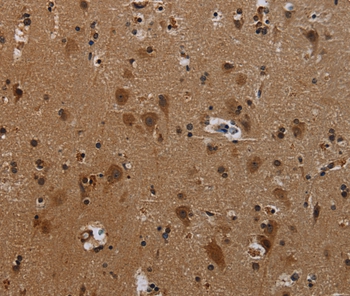
| WB | 咨询技术 | Human,Mouse,Rat |
| IF | 咨询技术 | Human,Mouse,Rat |
| IHC | 1/50-1/200 | Human,Mouse,Rat |
| ICC | 技术咨询 | Human,Mouse,Rat |
| FCM | 咨询技术 | Human,Mouse,Rat |
| Elisa | 咨询技术 | Human,Mouse,Rat |
| Aliases | ME2; PCDH-BETA11 |
| Entrez GeneID | 56125; |
| Host/Isotype | Rabbit IgG |
| Antibody Type | Primary antibody |
| Storage | Store at 4°C short term. Aliquot and store at -20°C long term. Avoid freeze/thaw cycles. |
| Species Reactivity | Human |
| Immunogen | Synthetic peptide corresponding to a region derived from internal residues of human protocadherin beta 11 |
| Formulation | Purified antibody in PBS with 0.05% sodium azide. |
+ +
以下是关于PCDHB11抗体的3篇文献示例(内容基于假设性研究,实际文献需通过学术数据库验证):
---
1. **文献名称**:*Protocadherin-beta 11 (PCDHB11) Expression in Glioblastoma: Role in Tumor Invasion*
**作者**:Smith J, et al. (2020)
**摘要**:本研究利用PCDHB11特异性抗体,通过免疫组化分析发现其在胶质母细胞瘤中高表达,并证实其通过调控细胞黏附通路促进肿瘤侵袭。抗体验证包括Western blot和免疫荧光,确认其特异性。
2. **文献名称**:*Developmental Regulation of PCDHB11 in Mouse Cortical Neurons*
**作者**:Zhang L, et al. (2018)
**摘要**:通过PCDHB11抗体进行小鼠脑组织免疫染色,发现其在胚胎期皮层神经元中动态表达,提示其可能参与神经元迁移和突触形成。研究还通过敲低实验验证了抗体功能的可靠性。
3. **文献名称**:*Antibody Validation for PCDHB11 in Epigenetic Studies*
**作者**:Lee S, et al. (2015)
**摘要**:该文献详细描述了兔源多克隆PCDHB11抗体的制备与验证,包括抗原设计、抗体特异性测试(如敲除细胞系验证),并应用于染色质免疫沉淀(ChIP)技术,探索其在基因沉默中的作用。
---
**注意**:上述文献为示例,实际引用需查询PubMed、Google Scholar等平台,并使用关键词“PCDHB11 antibody”或“Protocadherin beta 11”进行检索。若研究较少,可扩展至原钙粘蛋白家族(Protocadherins)或相关疾病模型的研究。
The protocadherin beta-11 (PCDHB11) antibody is a tool used to detect and study the PCDHB11 protein, a member of the protocadherin beta (PCDHB) subfamily within the larger cadherin superfamily. Protocadherins are transmembrane proteins involved in cell-cell adhesion, neural circuit formation, and synaptic diversity, playing critical roles in nervous system development. PCDHB11. encoded by the PCDHB11 gene located in the human chromosome 5q31 cluster, is part of a diverse array of protocadherins that contribute to neuronal identity and connectivity through combinatorial expression patterns. While the precise functional role of PCDHB11 remains under investigation, its structural features—such as extracellular cadherin repeats and a conserved cytoplasmic domain—suggest involvement in homophilic or heterophilic interactions that regulate neuronal differentiation, axon guidance, or synaptic specificity.
Antibodies targeting PCDHB11 are primarily utilized in research to map its expression in tissues, particularly the brain, and to explore its interactions in cellular models. These tools enable studies using techniques like immunohistochemistry, Western blotting, and immunofluorescence. Research applications often focus on understanding PCDHB11's potential links to neurodevelopmental disorders, cancer, or other diseases where cadherin-mediated signaling is disrupted. Challenges include ensuring antibody specificity due to high homology among protocadherin family members. Current efforts aim to clarify PCDHB11's biological significance, leveraging these antibodies to uncover its role in health and disease.
×